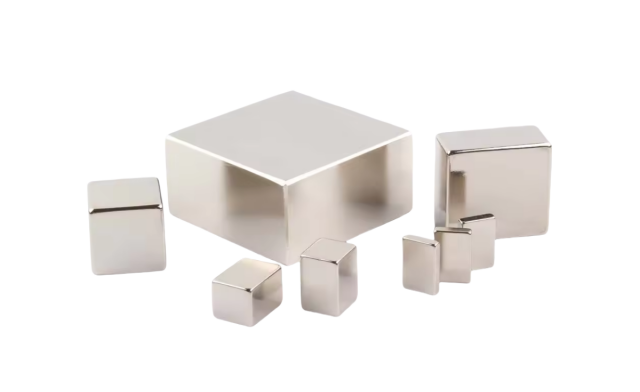Magnets are common in everything from small gadgets to complex machines. But not all magnets function the same way. While some remain magnetic for decades, others rely entirely on power or environmental conditions to work. The real difference lies between permanent magnets and what many call “regular magnets”—typically referring to electromagnets or temporary magnets. Understanding the distinction helps ensure the right choice in critical industrial applications.
A permanent magnet generates a magnetic field without needing electricity. This self-sustaining field results from the alignment of magnetic domains inside the material during manufacturing. Once magnetized, the structure locks these domains in place.
This property allows permanent magnets to be used in systems where constant magnetic force is needed but continuous power is not an option. Their ability to operate passively makes them ideal for long-term, maintenance-free performance.
Applications for these magnets range widely. Their use in energy-efficient motors, sensors, and acoustic devices speaks to their reliability. Engineers value them for stability and simplicity.

The term "regular magnet" usually applies to electromagnets and temporary magnets. Unlike permanent magnets, these types depend on outside conditions to function.
Electromagnets consist of coils wrapped around a soft iron core. When current flows through the coil, the core becomes magnetic. Switch off the current, and the field disappears. This on-demand magnetism is useful when temporary or adjustable force is required.
Temporary magnets work by induction. A material like soft iron becomes magnetic only when near another magnetic source. Remove the source, and the magnetism fades. These are often used in simple demonstrations or basic holding tools.
While permanent magnets are “always on,” electromagnets and temporary magnets depend entirely on environment or power input. That distinction makes a difference in how they are used.
Permanent magnets are made from materials that resist demagnetization. These include:
Neodymium Iron Boron (NdFeB): Extremely strong for its size, common in compact electronic and acoustic systems.
Samarium Cobalt (SmCo): Excellent for high-temperature and corrosive environments, favored in aerospace and defense.
Alnico: Good thermal stability, used in industrial sensors and instruments.
Ferrite: Affordable and rust-resistant, used in lower-performance applications.
These materials are engineered with high coercivity, allowing them to maintain their field even under mechanical or thermal stress.
Electromagnets use soft magnetic materials like silicon steel or pure iron. These materials magnetize easily but cannot hold their magnetism when current stops. They are chosen specifically for their responsiveness rather than long-term retention.
Temporary magnets also use soft iron or steel, depending on short-term influence from a permanent field. These materials are not suited for permanent or precision roles.
The structural goal in permanent magnets is durability, while in regular magnets, it's responsiveness.

Permanent magnets produce a fixed magnetic field once magnetized. They are not adjustable but provide consistent performance over time. This predictability is ideal in applications such as motor stators or static magnetic sensors.
Electromagnets allow real-time control. Engineers can switch them on or off, adjust strength, or reverse polarity—all by changing the current. That flexibility is valuable in dynamic systems like automated actuators or electromagnetic clutches.
However, this control requires wiring, power regulation, and heat management. Permanent magnets avoid all of this by remaining passive.
Temporary magnets offer neither control nor consistency. Their field appears only when externally influenced and disappears shortly after.
Heat affects all magnet types, but not equally.
NdFeB magnets lose strength above 80°C unless made with high-temperature variants.
SmCo magnets maintain stability even beyond 250°C, making them ideal for aerospace and high-precision tools.
Electromagnets generate heat during operation. High current can overheat coils or degrade insulation.
Temporary magnets are unstable even under modest temperature changes.
Neodymium magnets require protective coatings like nickel or epoxy to prevent corrosion. Samarium cobalt magnets, however, resist rust naturally, making them ideal in harsh or corrosive environments.
Electromagnets face different threats. Moisture can damage wires, and vibration may loosen connections. Their durability depends more on surrounding systems than on the core material itself.
Permanent magnets generally require less maintenance—though physical protection is still important.
Permanent magnets are used in generators and electric motors to convert between mechanical and electrical energy with minimal energy loss. Their ability to maintain a steady magnetic field enables highly efficient power delivery.
Brushless DC motors, often driven by neodymium magnets, are common in energy-saving systems. SmCo magnets are found in high-end turbines where temperature resistance matters.
High-performance telecommunications components use permanent magnets to stabilize signal flow and enhance frequency response. Miniaturized magnets are essential in antennas, base stations, and precision amplifiers.
Electromagnetic interference shielding also benefits from controlled magnetic placement enabled by rare-earth magnets.
Permanent magnets power components in MRI machines, surgical tools, and medical pumps. These systems rely on non-varying magnetic fields for accuracy.
SmCo magnets are preferred in devices requiring sterilization or high thermal cycling. Their resistance to demagnetization ensures patient safety and diagnostic reliability.
Headphones, microphones, and speaker systems all depend on strong, compact magnets for sound clarity. NdFeB magnets are the standard due to their power-to-weight ratio.
Whether for professional studio monitors or hearing aids, the quality of the magnetic field directly impacts audio fidelity.
In aerospace systems, weight and reliability are paramount. SmCo magnets are used in actuation systems, sensors, and fly-by-wire components due to their stability under extreme conditions.
These magnets maintain performance even when exposed to wide temperature swings or vibration during flight.
Defense systems demand field stability and resilience. Permanent magnets are used in guidance systems, actuators, and missile control mechanisms. SmCo's durability makes it the material of choice for military-grade applications.
Field failure is not an option in these environments, and the right magnetic material ensures operational confidence.

Permanent magnets may cost more upfront, especially rare-earth types like NdFeB or SmCo. However, they operate without energy input, saving cost over time. Their passive design also eliminates the need for backup power or active cooling.
Electromagnets, while cheaper to produce, require continuous power and maintenance. Over years, the energy cost alone can outweigh initial savings.
Temporary magnets are inexpensive but unreliable for anything beyond momentary use. Attempting to use them in a long-term system often results in failure or costly replacements.
Maintenance is another point of contrast. Permanent magnets, once installed and protected from corrosion, can last decades. Electromagnets are limited by wear on coils, connectors, and insulation.
Using the wrong magnet type causes avoidable design failures.
Installing an electromagnet in a battery-powered device leads to rapid power drain. A permanent magnet would have provided the same function without energy loss.
Using a temporary magnet in a feedback sensor might result in signal drift or complete failure, compromising system performance.
Even material choice within permanent magnets matters. Choosing NdFeB in a high-temperature aerospace setting could cause field degradation. SmCo would have been a better option despite the higher cost.
These mistakes aren't always catastrophic—but they waste time, inflate budgets, and reduce reliability.
Permanent and regular magnets may look similar, but their behavior, durability, and requirements vary significantly. Permanent magnets provide stable, long-term magnetic force without energy input, making them ideal for critical roles in power, aerospace, defense, medical, and communication systems. Electromagnets offer control but introduce complexity and ongoing energy cost. For industries that demand precision and longevity, Pourleroi supplies a wide range of permanent magnet solutions—especially NdFeB and SmCo products—tailored to meet technical and environmental demands.
For more information about our permanent magnet solutions, contact us at sales7@pourleroi.com or visit www.pourleroi.com.
By continuing to use the site you agree to our privacy policy Terms and Conditions.